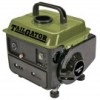Harbor Freight Tools 63024 User Manual - Page 11
Warning
 |
View all Harbor Freight Tools 63024 manuals
Add to My Manuals
Save this manual to your list of manuals |
Page 11 highlights
Safety Setup Maintenance WARNING TO PREVENT SERIOUS INJURY FROM ACCIDENTAL STARTING: Turn the Power Switch of the equipment to its "OFF" position, wait for the engine to cool, and disconnect the spark plug cap before performing any inspection, maintenance, or cleaning procedures. TO PREVENT SERIOUS INJURY FROM EQUIPMENT FAILURE: Do not use damaged equipment. If abnormal noise, vibration, or excess smoking occurs, have the problem corrected before further use. Follow all service instructions in this manual. The engine may fail critically if not serviced properly. Many maintenance procedures, including any not detailed in this manual, will need to be performed by a qualified technician for safety. If you have any doubts about your ability to safely service the equipment or engine, have a qualified technician service the equipment instead. Cleaning, Maintenance, and Lubrication Schedule Note: This maintenance schedule is intended solely as a general guide. If performance decreases or if equipment operates unusually, check systems immediately. The maintenance needs of each piece of equipment will differ depending on factors such as duty cycle, temperature, air quality, fuel quality, and other factors. Note: The following procedures are in addition to the regular checks and maintenance explained as part of the regular operation of the engine and equipment. Procedure Brush off outside of engine Check engine fuel/oil mixture level Check air cleaner Check sediment cup Change engine oil Clean air filter Check and clean spark plug 1. Check/adjust idle speed 2. Check/adjust valve clearance 3. Clean fuel tank, strainer and carburetor 4. Clean carbon build-up from combustion chamber Replace fuel line if necessary Before Each Use Monthly or every 20 hr. of use Every 3 mo. or Every 6 mo. or 50 hr. of use 100 hr. of use Yearly or every 300 hr. of use Every 2 Years * ** ** ** *Service more frequently when used in dusty areas. **These items should be serviced by a qualified technician. Checking and Filling Fuel WARNING! TO PREVENT SERIOUS INJURY FROM FIRE: Fill the fuel tank in a well-ventilated area away from ignition sources. If the engine is hot from use, shut the engine off and wait for it to cool before adding fuel. Do not smoke. 1. Clean the Fuel Cap and the area around it. 2. Unscrew and remove the Fuel Cap. 3. Remove the Strainer and remove any dirt and debris. Then replace the Strainer. Note: Do not use gasoline containing more than 10% ethanol (E10). Do not use E85 ethanol. Add fuel stabilizer to the gasoline or the Warranty is VOID. Note: Do not use gasoline that has been stored in a metal fuel container or a dirty fuel container. It can cause particles to enter the carburetor, affecting engine performance and/or causing damage. Operation Maintenance ITEM 63024 For technical questions, please call 1-888-866-5797. Page 11















